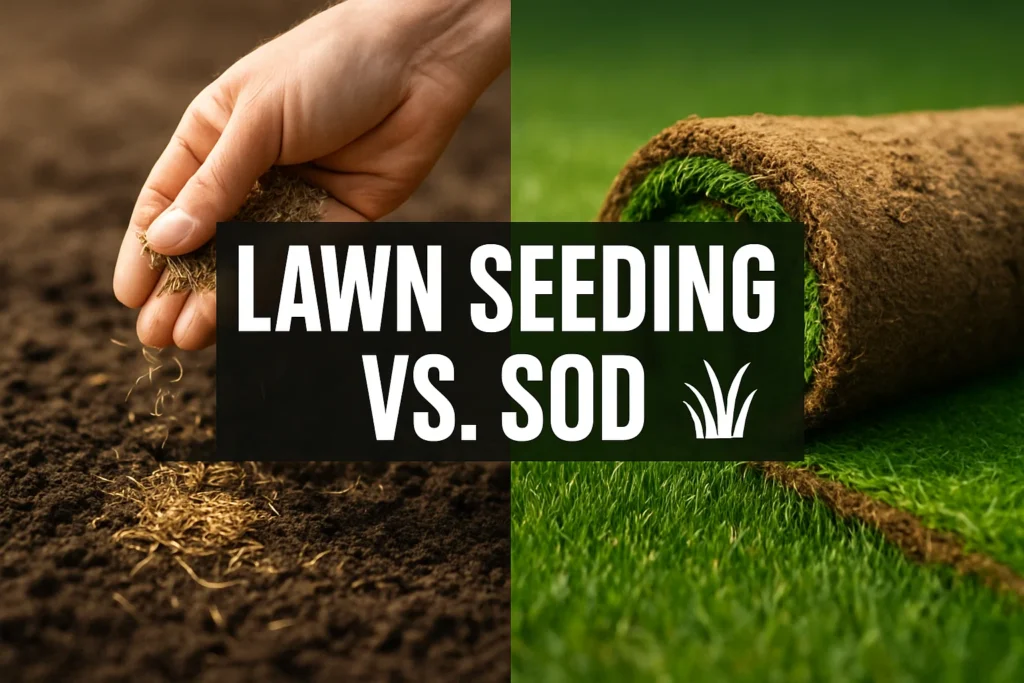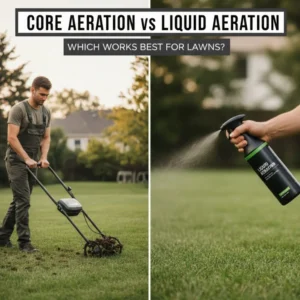When deciding how to establish or renovate your lawn, the choice between lawn seeding vs. sod is crucial. Each of the two approaches has its own benefits and limitations based on your budget, schedule, climate, and lawn objectives. This guide is a breakdown of all you need to know to make an informed decision.
What Is Lawn Seeding vs. Sod?
Lawn Seeding is the process of sowing grass seed on bare soil. The seeds sprout and develop into a full lawn within months. This is a technique that begins your lawn at the ground level and enables roots to grow naturally in your soil.
Sod is a pre-grown grass with roots and soil, harvested in rolls or sections at specialized farms. Sod is installed on top of your soil as a living carpet, providing an immediate lawn that can be used in just weeks.
| Aspect | Lawn Seeding | Sod |
| Pros | Lower cost, more grass variety, stronger roots | Instant lawn, erosion control, and quick use |
| Cons | Longer establishment, erosion risk, and more watering | Higher cost, requires professional installation, sensitive to watering errors |
| Best For | Budget-conscious DIYers, patient homeowners | Quick results, new construction, erosion-prone areas |
Key Differences Between Seeding and Sodding
When planning how to seed or sod your lawn, it’s important that you know the main differences between each. Seeding is done when grass seeds are sown directly into the soil and grow on their own as time passes. Conversely, sodding is the process of planting pre-grown strips or squares of grass that already have roots, to give an instant lawn. Each method has its pros and cons, depending on factors such as budget, schedule, upkeep, and end result for your lawn.
Time to Establish and Appearance
Seeding: Requires 2 to 4 months to form a mature, walkable lawn. During such time, there is a frequent requirement of watering the grass hugely to let the seed sprout and grow.
Sod: is an instant green lawn that appears full and plush right after installation. In most cases it should root completely in 2 to 3 weeks and be ready to be walked on as for regular-purpose sod.
If you are in a hurry and need to have an instantly attractive lawn, sod is the best option. If you’re patient and prefer to save money, seeding is great.
Maintenance and Durability
Establishing cover from seeding depends on regular watering and measures to prevent erosion, especially in the beginning. However, in the long run, seeded lawns send roots deeper which allows them to be more drought and condition tolerant.
Initially, sod requires intensive care, such as frequent watering and avoiding heavy traffic. Sod is susceptible if not layde properly or watered or fed enough, and can be difficult to take to other soil situations.
Grass Variety and Adaptability
There are common grass types and blends that you can select from, so you can choose the most appropriate varieties for your climate, soil, levels of sun and shade, and the way in which your lawn will be used.
Sod lacks a variety of choices and the sod may not be perfectly suited for your local area’s conditions, and that can make it tough for roots to grow.
Cost Comparison: Seed vs. Sod
While weighing lawn seed vs sod options, it’s helpful to know the costs. In this section, we will also break down the cost of each method, so that you can budget accordingly and make the decision that is best for you.
How Much Does Sod Cost Per Square Foot?
Prices can differ depending on variety, geographic location, and source. Sod prices average between $0.86 & $1.75 per square foot. This will normally account for the grass itself, yet not necessarily the cost of installation, payments which if not included could increase the price substantially. The above prices are for basic sod and premium and specialty sod may cost more.
Cost to Re-Sod Yard: Is It Worth It?
To re-sod a yard you need to take out the old or damaged grass and put in new sod. The overall cost will vary based on yard size, labor, and if additional soil preparation is needed. The average homeowner spends between $1,000 and $3,000 to resod an average size yard (1,000 to 3,000 square feet).
Re-sodding is more expensive than seeding but it gets the look great or good fast as well as usability fast. It’s not bad for the money if you need to cover a plot with thick, lush grass in a hurry, or if you have a yard that’s impossible to seed the traditional way thanks to erosion or a rowdy dog with heavy feet.
Cost of Grass Seed vs. Sod Installation
Grass seed is cheaper ($0.08-$0.20/square foot), depending on the quality of the seed type. Installation costs for seeding are also typically lower because many homeowners can DIY the job, saving on labor costs.
By comparison, you’ll need professional sod installation in the majority of scenarios, which further drives up the overall costs. Installation costs may be between 0.50 and 1.50 per square foot, depending on labor rates in the area in which you live and the complexity of the project.
Lawn Seeding vs. Sod
| Cost Factor | Lawn Seeding | Sod Installtion |
| Material Cost per sq. ft. | $0.08 – $0.20 | $0.86 – $1.75 |
| Installation/Labor Cost | Minimal to none (DIY possible) | $0.50 – $1.50 |
| Total Average Cost per sq. ft. | $0.08 – $0.20 | $1.36 – $3.25 |
| Typical Time to Establish | 2 – 4 months | Instant lawn, ready in 2 – 3 weeks |
| Maintenance Cost | Moderate (watering, care) | Higher initially (watering, root establishment) |
| Suitability for DIY | High | Low to moderate |
This comparison of costs shows us that although seed is much less expensive to start, sod costs more in the beginning, but offers an immediate landscape, for a higher price. Your decision should balance budget considerations, the timeline on which your property will be ready for use and lawn usage priorities.
Which One to Choose?
Select Seeding if: You’re willing to invest the time to care for your lawn, you’re cost-conscious, and you want the option to customize the types of grass used. Great for repairing your lawn or establishing new lawns with patience.
Choose Sod: If You Want Instant Results, Have a Larger Budget, or Need an effective Erosion Control on building sites or slopes Immediately. Also good for when you need a cohesive look in a hurry.
Conclusion
You can use either lawn seeding or sod to grow a beautiful, healthy lawn, but which option makes more sense depends on what matters to you. Sod provides instant gratification and immediate usability but at a higher cost and maintenance risk. Seeding is also cheaper and more flexible, but can be fiddly and demands patience and precision. Consider your budget, timeline and lawn conditions when deciding which method is best for your outdoor space.
FAQ’s
Seeding costs an estimated $0.08 – $0.20 per square foot, and sod is priced from $0.86 – $1.75 per square foot including installation.
Although DIY installation is an option, sod installation is something you may want to leave in the hands of professionals, who can prep your soil and provide adequate watering so that your sod roots properly.
Lawns that are seeded typically have deeper roots and are more sustainable over the long term. Sod can take root fast but may be more susceptible if not nurtured.
Sod can generally be walked on after 2 weeks to a month once you see roots.
Yes, sod gives immediate ground cover which is good for controlling erosion on slopes, at new construction sites, etc.



